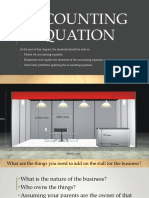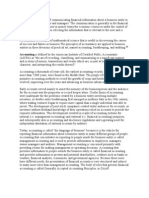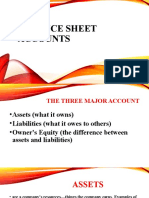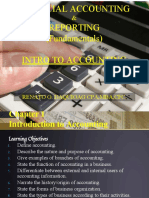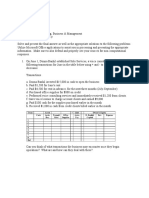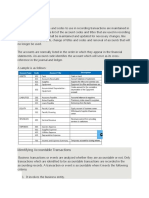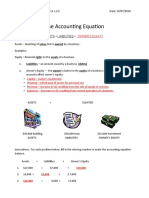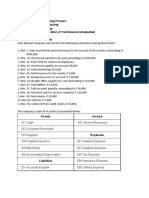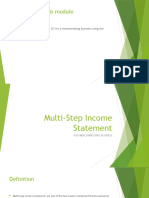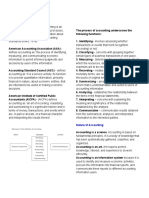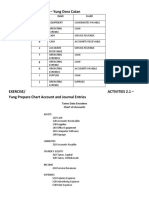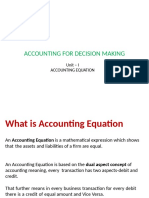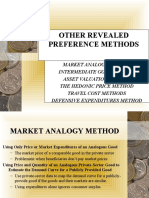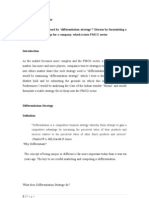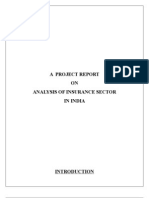100% (1) 100% found this document useful (1 vote) 2K views 18 pages Accounting Equation
Every transaction affects the business in two W3YS by the same amount. Every transaction has its effect on the ACCOUNTING EQUATION in such a manner that both sides remain equal. After studying this lesson, you will be able to:. State the meaning of accounting equation; appreciate the importance of Accounting Equation.
Copyright
© Attribution Non-Commercial (BY-NC)
We take content rights seriously. If you suspect this is your content,
claim it here .
Available Formats
Download as PDF, TXT or read online on Scribd
Go to previous items Go to next items
Save Accounting Equation For Later 6
ACCOUNTING EQUATION
6.1 INTRODUCTION
You have already studied about Dual Aspect Concept and the various
basic Accounting terms viz Assets, Liabilities, Capital, Expenses and
Revenue. Accordiag to this concept, every transaction affects the
business in two ways by the same amount. Suppose, a businessman
starts his business with Rs.2,00,000. In the books of accounts,
Rs.2,00,000 will be recorded as an asset (Cash) and an equivalent
. amount will be shown as liability against the owner, In this example,
you have noted that assets are equal to liabilities. We can present this
in mathematical form
Assets
This mathematical, expression is Accounting Equation.
Eyery transaction has its effect on the Accounting equation in such a
manner that both sides remain equal. Now, we shall ‘take different
business transactions and see their subsequent effect on the accounting
equation.
6.2 OBJECTIVES
After studying this lesson, you will be able to:
© state the meaning of accounting equation;
—�Accounting Equation :: 65
SS =
© appreciate the importance of accounting equation;
© point out the effect of each aspect of a transaction on the
accounting equation; :
© establish that assets “are equal to liabilities and capital;
© prepare accounting equation from given transactions.
6.3 ACCOUNTING EQUATION
The recording of business transaction in books of accounts is based on
a fundamental equation called Accounting Equation. Whatever business
possesses in the form of assets is financed by proprietor or by outsiders.
This equation expresses the equality of assets on one side and the
claims of outsiders (liabilities) and ownérs or proprietors on the other
side. In Mathematical form,
Assets = Li
s+ Cap
Whenever an asset is introduced in the business, a corresponding liability
also emerges. A business does not have any amount of its own. Hence,
we can say that
Business owns Nothing, And Owes Nothing,
What it Owns, it owes
Let us see the effect of business transactions on Accounting equation.
‘These transactions increase or decrease the assets, liabilities or capital.
Every business has certain assets. For example, Sunita has started
business by contributing Rs.2,00,000 as Capital. It can be said that
asset in the form of Cash has been created for the business concern. -
Hence, Cash = Capital
Rs. 2,00,000 = Rs.2,00,000
Sunita later on purchases furniture for Rs.20,000 and machinery for
Rs.60,000. Now the position of the assets is a follows:
i�Cash + Furniture + Machinery
2,00,000 = —1,20,000 + 20,000 + 60,000
(2,00,000 - 80,000)
From the above business transactions, we find that
Capital = Assets
or
Assets = Capital
Increase or decrease in capital will result in the corresponding increase
or decrease in assets. For example, Sunita introduces Rs.50,000 as
additional capital. Then
Capital === — Cash + Furniture + Machinery
2,00,000 = 1,20,000 + 20,000 + 60,000
+ 50,000 + 50,000
730,000 = 1,70,000 + 20,000 + 60,000
Every business concern, generally borrows money from outsiders in
order to carry on its activities. In other words, every business concen
‘owes money to outsiders. These assets are financed by the funds supplied
by proprietors and outsiders. Money borrowed from outsiders is called
as liability,
For example, Sunil started business by investing Rs.5,00,000 and
borrowed from Ajay Rs.1,00,000. Hence the amount of asset (cash) is
Rs.6,00,000. The accounting equation of these two transactions will be —
‘Asset (cash)= Capital © + —_Liability (Loan from ajay)
6,00,000 = 5,00,000 + —1,00,000
‘The fact that business receives funds from proprietors and creditors
and retains all of them in the form of various assets, can be presented
in terms of an equation as
Assets Liabilities or A= C + L
Liabilities Capital or L = A-C
Capital = = Capital or C = A-C�Accounting Equation :: 67
Let us consider some more examples:
Rahul started business by introducing Rs.3,00,000 as capital. He also
invested Rs.2,00,000 which he borrowed from Shweta.
Assets = Capital + Liabilities
Cash Loan from Shewta
5,00,000 = 3,00,000 + 2,00,000
She purchases goods from cash Rs.50,000
Assets = Capital + — Liabilities
Cash + goods
Old equation 5,00,000 = 3,00,000 + —2,00,000
effect of 50,000 + 50,000 = 0 :
transaction :
New Equation —_4,50,000+50,000 = — 3,00,000 + —2,00,000
He paid Shewta Rs.50,000
Assets. = Capital: + Liabilities
Cash + goods
Old equation 4,50,000 + 50,000= —3,00,000 + 2,00,000
effect of 50,000 +0 0 - 50,000
transaction
‘New Equation 3,00,000 + = 1,50,000
In the above example, expenses and revenue have not been considered.
They also affect the accounting equation. Their effect is always on the
capital account.
Every business concern has to meet certain expenses in its day-do-day
operations such as payment of salaries, rent, insurance premium, postage,
‘wages, repairs of machines, etc. These expenses are paid regularly. All
expenses teduce the cash balance as they. are paid in cash. These
expenses reduce the net income of the business. As the net income is
the income of*proprietor, which is represented by the capital account,
so all expenses are deducted from the Capital account.�Similarly, every business concern receives certain revenues during its
‘day to day operations, such as rent received, commission received, etc.
Revenue is added to the cash balance as it is received in terms of cash.
. Revenue increases the net income of the business and hence, it is
added to the capital account.
Now, the Accounting Equation is represented by .
Assets Capital + liabilities
+ revenue (cash) + revenue
— expenses (cash) ~ expenses
or
A=C4L
‘Accounting equation is thus affected by every business transaction.
Any increase or decrease in assets, liabilities and capital can be identified
by preparing accounting equation. It also shows that every business
transaction satisfies the dual aspect concept of accounting. It also serves
as a basis for preparing the Balance Sheet.
INTEXT QUESTIONS 6.1
L Fill in the blanks with correct words:
a. Accounting equation is also called as ....
equation,
b. Assets = + Liabilities
¢. Accounting equation satisfies the ...
accounting.
. concept of
d. Capital = Assets —
c. Accounting equation serves as a basis for preparing,
4
f. "Liabilities =�Accounting Equation ::6)
IL Multiple choice questions:
Choose the correct alternative in the following questions:
Ll In accounting equation, assets are equal to
a. Capital only
b. Capital + liabilities
c. Capital — Liabilities
d.__.. Liabilities — Capital
2. — Which of the following lists is a list of. assets only?
a. Cash, Stock, debtors, Machinery
b. Cash, creditors, loan
c. Capital, furnitu?, bills payable.
4. Capital, prepaid expenses, outstanding expenses.
3. Which of the following lists is a list of liabilities only?
a. Cash, Stock, debtors
b. Cash, loan, creditors
©. Creditors, loan, bank overdraft, bills payable
4. Prepaid rent, salary outstanding, bills F ceivables.
64 EFFECT OF TRANSACTIONS ON ACCOUNTING
EQUATION
“You have learnt’ that assets, labile and capi*al are the three basic
elements of every business transaction, and ther relationship is expressed
in the form of accounting equation which always 1emams equal At
any point of time, there can br a change sn the individual asset, liabilit
or capital, but the two sides ef the accounting equanon always remain
equal. Let us examine this fact by taking up some more transactions
and see how these transactions affect try accounting equation,�Suppose, Rajni starts her business and the following transactions take
place:
1 She started business with cash Rs.5,00,000 introduced as capital.
Assets = Liabilities + Capital
cash
Effect of the Rs.5,00,000 = 0 + — Rs. 5,00,000
transaction
‘This transaction means that Rs.5,00,000 have been introduced by Rajni
ia terms of cash, which is the capital for the business concern. Hence
on one hand, the asset (cash) has been created to the extent of
Rs.5,00,000.
2. She purchased furniture for cash worth Rs.50,000
Assets = ‘Capital + Liabilities
Cash + Furniture
Old equation 5,00,000 + 0 = 5,00,000 + 0
effect — “50,000 + 50,000 = 0 - 0
transaction
New equation 4,50,000 + 50,000 = 5,00,000 + 0
ee een ace
This transaction has its effect only on the assets, as one asset has been
purchased against the other. In this transaction, furniture is purchased
against cash given. Furniture and cash both are assets. Hence furniture
is introduced by Rs.50,000.
3. She purchased goods for cash Rs.10,000
Assets = Capital + Liabilities
Cash + Furniture+ Goods = Capital + Liabilities
Old eq. 4,50,000 + 50,000 +0 = " 5,00,000 + 0
Effect of -10,000 +0 + 10,000 = 0 +0
the transaction
_
New 440,000 + 50,000 + 10,000 = 5,00,000 + 0
equation
Goods purchased is an asset and in return cash paid is also an‘asset .�. . Accounting Ej::ation ge 71
“Hence in this transaction, there is an increase in one asset (goods) and -
decrease in the other asset (cash) by Rs.10,000 leaving the capital and
abilities untouched.
4, She purchased goods from Rohit for Rs.40,000
Assets = Capital + Liabilities
Cash + furniture + Goods = Creditors *
Old Equation 4,40,000 + 50,000 + 10,000 = 5,00,000-+ 0
effect 0 +0 + 40,000 = 0 + 40,000
-New Equa- 4,40,000 + 50,000 + 50,000 = — 5,00,000 + 40,000
‘tion
In this transaction, goods have been purchased on credit from Rohit,
hence there is an increase in the assets (goods) by Rs.40,000 and also
an increase in the liabilities by Rs.40,000, as the business concern now
owes money to Rohit.
In any transaction, whenever cash payment is not mentioned and.
the name of the seller is given, then the transaction is always a
credit transaction.
3. She sold goods to Rahul for Rs.20,000: the cost of the goods is
Rs.15,000.
Assets = Capital + Liabilities
Cash + Furniture + Goods + Debtors
OF eg. 4,40,000 + 50,000, + 50,000+0 © = 5,00,000 + 40,000 .
Effect of the 0 +0 ~ 15,000 + 20,000 = 5,05,000 + 40,000
Transaction _4,40,000 + 50,000 + 35,000 + 20,000 = 5,05,000 + 40,000
Ee _
New Equation 4,40,000 + 50,000 + 35,000 + 20,000 = 5,05,000 + 40,000
In this transaction, goods have been sold on credit to Rahul, so there
is a decrease in the assets (goods) by Rs.15,000, and an increase in the
assets (Rahul) by Rs.20,000 as money has to be collected from Rahul.
In this process, the proprietor has a gain of Rs.5,000 which is added
to the capital :
Whenever goods are so'd and nothing about cash received is mentioned
and-the name of the purchaser is given then that transaction is treated
as credit wansaction. .�6. She paid salaries to clerks for Rs.12,000 - 7
Assets, = Capital = +1. bilities
Cash + Fumiture + Goods + Debtors
Old eq. 4,40,000 +50,000 +35,000 +20,000 = 505,000 + 40,000
Effect of the 12,000 +0 | +0 +0 = = -12,000 +0
transaction
‘New Equation 4,28,000 +50,000 — +35,000 +20,000 = 4,93,000 + 40,000
In this transaction, salaries paid to clerks is an expense for the business
concer. Since salaries is paid in terms of cash, hence cash as an asset
is reduced by Rs.12,000 and.as. all expenses reduce the capital, so
capital is also reduced by Rs.12,000.
7 Cash paid to Rohit Rs.20,000 _
As ets Capital +Liabilities
Cash Furniture +Goods +Debots
Old eq. 4,28,000 50,000 +35,000 +20,000 = 4,93,000 +40,000
Effect of the - 20,000 -0 . +0 = =20,000
transaction
‘New Equation 4,08,000 +50,000 - +35,000 +20,000 = 4,93,000 +20,000
In this transaction, cash has been paid to the creditors, Rohit Rs.20,000,
hence cash as an asset is reduced by Rs.20,00 and also the liability
_ Rohit) is reduced by Rs.20,000.
From the above transactions, now you are clear as to how every
transaction has its effect on the accounting equation without disturbing
the equality of the two sides.
5
COMBINATIONS OF THE EQUATION
The inter-relationship between assets, liabilities and capital can be
expressed in various forms. Nine combinations can be created.
Increase or decrease m one has a corresponding Increase or
Decrease in Itself or the other.�Accounting Egitation:
et us study the nine combinations with examples.)
i) _nerease in asset with corresponding increase in capital
Example: Started business with cash.
ii) Increase in asset with corresponding increase in liabilities.
Example: Goods purchased on credit.
iii) Decrease in asset with corresponding decrease in capital
Example: Cash withdrawn from the business by th. proprietor
for personal use. ‘
iv) Decrease in asset with corresponding decrease in liability
Example: Cash paid to the creditor.
v) Increase and decrease in assets
Example: Furniture purchased for cash,
Goods purchased for cash, etc.
vi) Increase and decrease in liabilities.
Exaniple: Payment made to creditors by taking loan from bsnk.
vii) Increase and decrease in capital.-
Example: Interest on Capital
viii) Increase in liabilities and decrease in capital.
Example: Wages due but not yet paid, outstanding salaries
ix) Increase in capital and decrease in liabilities.
Example: Conversion of loan into capital.�Let us consider another Illustratio~:
once again:
Mlustration
1.
Shashi started business with :
Cash
Goods
Machine
He purchased goods for cash
He sold goods (costing Rs.20,000)
He purchased goods from Ravi
He paid cash to Ravi in full settlement
He sold goods to Vikas (costing Rs.54,000)
He received prompt payment from Vikas and
discount allowed Rs.2,000
Salaries paid by him
Rent outstanding
Prepaid insurance
Commission received by him
Amount withdrawn by him for personal use
Interest an capital es by him
Depreciation chargéd on Machinery
Purchased goods from Sandeep
cd stud the ac-cunting .quation
Rs.
2,00,606
1,20,000
80,000
50,°00,
25,000
70,000
69,000
60.000
58,000
40,0:0
4,000
1,000
3,000
30,000
2,000
8,000
1,70,000�Accounting Eqis
wopenby Mon
000°0L “SH
wry wo
spoo8 paseysitg +
+ 000°02T + 000°SL‘T
"
°
+
©
+
&
2
3
ooo'so’ + 0” + 000°0L+
0 +0 + 0004+ =.0 +0 +0 + 000°0L +0.
o00'so'y, 000‘0s‘1 + 000'SL‘T
00°57, 5H 105
7 . (000'02 “Sy 3805)
o's +0 +0 =o +0 +0 + 00002 - d00'sz+ -- spoof.piog
. 000'00% + 0 +0 - = 0 +0 ++ 000°08 + 000‘0L'I + 000‘0S‘T woprenba oN,
: 00'S “Fu 205
0 +0 +0 =0 +0 +0 + _000%0S + 000°0s- posuyaind spoon 'Z
000'08 amyUW
000°02"1 Spoon
000°0z'I + o00'00'2 000'00'2 useD
000‘00'r *
: susdxa :
Tarde) + Supurising + siompery = predig = + SHoNqeg + SUMPEWY + - SPoOH + —YSED
sone�;
opo's9'e = + 000'r +0 = 000 +0 + 000°08 + 000'99°T + 000'E7'T ‘wonEnby Mon
000 “su
o> +0 3: +0 = 001 +0 +0 +0 + 000I- souemsuy predarg “Q]
000°99'€ = + 000'F +0 = 0 +0 + 00008 + 000°99°T + 000°FZ'T ‘wonenba May
. 000'r “a
000'% > 000° +0 = 0 +0 +0 +0 +0 Supuesino may “6
cove + 0 +0 =o +0 + 000°08 + 000°99'T +.000‘r2‘I wonenby MeN
“ 000'0r “sa
o00'or - 00 +0 =o +0 +0 +0 + 000°0r- pred souzjes “g
ooo’ = + 0 +0 = 0 +0 + 000°08 + 000'99'T + 000'r9'T
. 000°2 ‘sy mmoosip
pre sexta wow
paatooar qwowéed
o00'e + 000°RS+
wonenbg Mon
000°09 “sy 103
000'rS “sy
PICS spooH “9
onenbg-MoN
000'69 “sy sow
“Tones ny ur aey
1 opeut qoueg *¢
ooovlb = + 0 en) = 0 + 00009 + 000°08 + 000°99'I + 000'90'L
000°9 +0 +0 = 0 + 0009 + 0 + 000s -0
000'90'r + 0 +0 = 0 +0 + 00008 + 000°07'Z + 000°90'r
000° 000‘0L- 0 + 000°69-
+
°
+
u
°
+
7
+
°
+�o00'TE'E
ooo'le'e
000'r
o00'so's
ooo'rs't
000‘0L'T
000°0L'T+
000'1
000°¢L
0
00'so's
000°S0'S
000'9E'E + 000'96
uonunbg MON
ooo'ou't “su
doapng woyy
coorou't +0 poseyoind spoop °$]
OO0'TE'E
000°8
000'r
0
000°:
000°%L
000°8
uonenby mon
000'8 “Su
Asouryoey
uo uonsisaideg “F
000°99't + 00096
0 +0
o00'6e'e
000°%-
000%
000"
o00‘08.
0
000°99't + 000'96 uopenbg MON
000% “FY
jeuded wo ysazauy “ey
0 +0
000'6E'.
oo0'oe
000°69'E
000°¢
000'r
000'r
000't
000°
oo0'o8
00°08
woenbg #9y
ooo'oe “su
0 + 000'0E~ .| umtp WE NOwY “ZI
000°99' + 000'96
uojsenbg MeN
ooo'e SY
000°99'1 + 000°92'T
0 + 000'E+�18.:: Accountancy
Ot
INTEXT QUESTION 6.2
1
Goods purchased from Ritu for Rs.60,000. What effect will the
transaction have on the Accounting Equation?
a Increase in assets and decrease in liability.
b. Increase and decease in asset.
c. Increase and decrease in fiability.
d. Decrease in asset and decrease in liability.
Rent outstanding Rs.2,000. What effect will this transaction have
on the Accounting Equation?
a. Increase and decrease in asset.
b. Increase and decrease in liability.
c. Increase in liability and increase in asset.
d. Increase in liability and decrease in Capital.
Interest on drawings amcunted to Rs.5,000, What effect will this
transaction have on the Accounting Equation?
a. Increase and decrease in asset.
b. Increase and decrease in liability.
c. Increase and decrease in Capital.
d. Increase in asset and Increase in liability.
65
WHAT YOU HAVE LEARNT
Business transaction means exchange of goods and/or services
for value and any other financial activity undertaken in the course
of the business.
Every business transaction is recorded on the basis of Accounting
Equation.
en�‘Accounting equation is a statement showing the equality of assets
on one hand and the capital and liabilities on the other:
‘Assets = Capital + Liabilities (A = C +L)
Every business transaction has its effect on the Accounting
Equation.
Business owns nothing and owes nothing. What it owns it owes.
Under any circumstance, the equality of the Accounting Equation
remains same.
‘The effect of expenses and revenue is always on the Capital
Account, Expenses rediice’ the Capital and revenues increase it.
10.
6.6
eee
Every business transaction satisfies the’ Dual Aspect Concept.
‘Any increase or decrease in dne element of Accounting Equation
has a corresponding increase or decrease on the other element or
itself. :
TERMINAL QUESTIONS
Answer the following questions in 1-10. words.
a If a firm borrows a sum of money, what will be its effect
on the Accounting Equation?
b. Give two examples — one showing the effect only on
+ assets and the other on liabilities only.
c. How will you show income received in advance in the
accounting equation?
4. If goods costing Rs.8,000 are sold for Rs.8,500, how will
the capital be affected?
‘Answer the following in (30-50 words) ,
a.” What is an Accounting Equation? =.”
b. How are revenue and expense treated in Accounting
Equation? .�“Accounting Equation remains intact under all circumstances”.
Justify this statement with the help of examples (100-150 words).
Prepare Accounting Equation on the basis of the following:
(@ Karan started business with cash Rs. 1,60,000.
(i) He purchased furniture for cash Rs.16,000.
(iii) He paid rent Rs.1,600.
(iv) He purchased goods on credit Rs.24,000.
(v)_ He sold goods (cost price Rs.16,000) for Rs.40,000 for
cash.
Akshay had the following transactions: Rs.
() Commenced business with cash 2,50,000
(i) Purchased goods for cash 1,00,000
(iii) Salaries paid . 2,500
(iv) sold goods for cash Rs.2,00,000 costing 1,50,000
(v) Rent outstanding 500
(vi) Purchased goods on credit 1,50,000
(vii) Purchased Machinery on credit 25,000
(vini) Purchased Motorcycle for personal use 25,000
(ix) Purchased building for cash 1,00,000
Use Accounting Equation to show the effect of the above
transactions on the assets, liabilities and capital.
Show the Accounting Equation on the basis of the following
transactions
Rs.
() — Shivam started business
Cash . 5,00,000
Goods 2,00,000
(it) He purchased machinery for cash 2,50,000
————_—_�° Accounting Equation = 81
ere
(iit) He purchased goods from Ramesh 1,00,000
(iv) He sold goods to Suresh (Cost Rs.25,000) 30,000
(%) Paid insurance premium 5,000
(vi) Salary outstanding 10,000
(vii) Depreciation of Machinery 25,000
(Vili) Interest on Capital 3,000 .
(x) Amount withdrawn for personal use 18,000
(%) Interest on drawings ° , i 900
(xi) Rent received in advance 1,500
(xii) Cash paid to Ramesh 50,000
(xiii) Cash received from Suresh ; 15,000
6.7 ANSWERS TO INTEXT QUESTIONS .
61 1 a. balance sheet equation
b. capital
© dual aspect
d. liabilites
e balance sheet
£ assets
IL 1. b. Capital + Liabilites
2 a
3c
62 1 1 a




